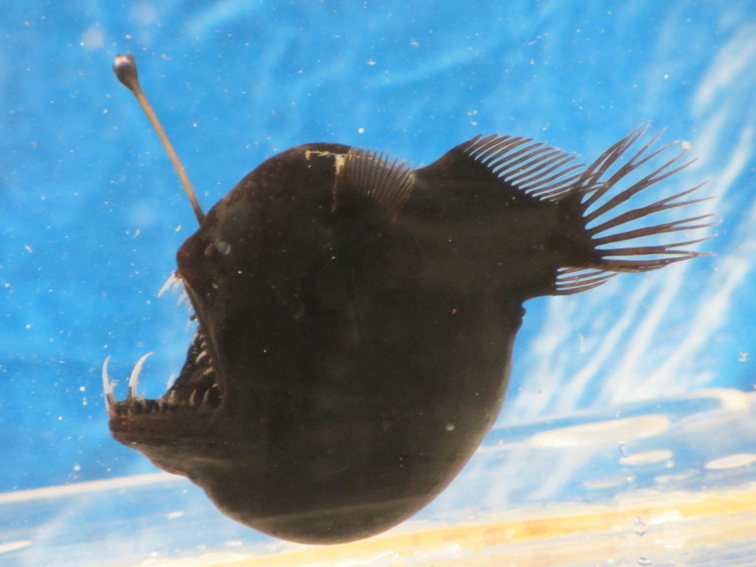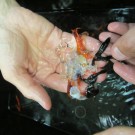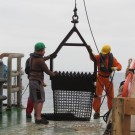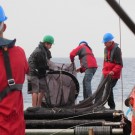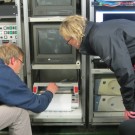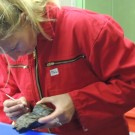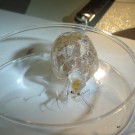When I received the email seven months ago that I am joining the SONNE in Namibia the upcoming summer, it still seemed to be a lifetime ahead. The excitement increased as the departure came closer and now, after a week on board still hasn’t faded a bit.
I am a marine ecosystem- and fisheries sciences student and couldn’t believe my luck when I learned that one part of this expedition included deep sea fishing, which was accomplished using a special net construction brought and operated by an Australian scientist.
For the first four days after we arrived at a little sea mountain cluster at the Walvis Ridge the net brought the most beautiful ugly creatures to the surface. Unfortunately, not exactly what the group of deep sea fish scientists, specialized in fish eyes, was hoping for, but nevertheless amazing.
After we marveled at the bioluminescence and fluorescence in the dark, the container with the net content was placed on the lab floor and crew members and scientists alike would gather. The brave and curious would roll up their sleeves head through the water, densely filled with gorgeous jellyfish, salps, polychaetes, squid, amphipods, bright red shrimps, lamp- and hatchet fish, gulper eels and viper fish….
Already the second net brought to daylight my absolute highlight of this cruise – an approx. 8 cm roundish angler fish with most scary teeth and the longest imaginable fishing pole dangling from his head. What a beauty. Seriously, who can say that he or she had seen one alive!!!
The second part of our journey admittedly didn’t excite me as much at first. But soon I was infected by the contagious passion of the geologists who’d excitedly watched the Rikadenki, a device recording the tension on the rope, waiting for bites which indicate if the dredge might have collected something spectacular. During our twelve-hour night shifts we would monitor the screens, watching how the unknown bathymetry of the ocean bottom was laid out for us on the computer monitor. Or we’d observe the progress of the dredge dragged a few kilometers along the sea mountain slope under our vessel.
I enjoyed the buzzing atmosphere right before the dredge came back on deck when everyone was keeping their fingers crossed, hoping for bucket loads of basalts – a certain eruptive rock. The geologists had more luck with the rocks. The content of the dredge varied from one enormous boulder to a couple pebbles, some of them the right ones. The rocks were immediately brought to the lab where they were washed, cut into pieces, washed again, described and bagged for further analysis in Germany.
I quickly learned some basics how to differentiate the “good” from the “bad” and how to describe the samples using geological terminology. Speaking of basics, in geological terms 80 mio. years isn’t apparently very old. I even forgot the angler fish for a while, realizing I was holding something brought up from 3.500 m depth, having been there for so long I am unable to wrap my head around it.
Of course we haven’t only been working on board. There was plenty of time for the scientists and SONNE crew to mingle doing things like movie night, card games, having a relaxing after-work meeting or just enjoying the rocking sensation while reading a book. Fortunately the ships doctor had plenty of “magical” pills with her to prevent a mayor loss of man power owing the rough sea.
To wrap it all up, being on original RV SONNE with such an interesting, international, knowledgeable and fun group of people will always stay an unforgettable memory and journey. I now very much look forward to the second half of the cruise which will be filled with lectures and practical seminars. Hopefully the time won’t pass to quickly….
Maike Ladehoff
- Deep sea findings. Photo: Maike Ladehoff
- Dredge. Photo: Maike Ladehoff
- Fishing net. Photo: Maike Ladehoff
- Geologists at Rkadenki. Photo: Maike Ladehoff
- Maike Ladehoff in the laboratory. Photo: Stefan Linsler
- Phronomid amphipod. Photo: Maike Ladehoff
